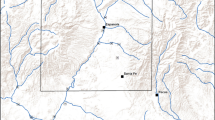Abstract
Understanding the driving forces and mechanism of land use change is a key issue in land change science, and has received much attention over the past 30 years. While many driving forces have been identified, the mechanism of land use change is still unclear, mainly because of limited knowledge of the underlying motivation for land use change. Traditionally, the underlying motivation for land use change was ascribed to people’s pursuit of satisfying their own demands or that of profit maximization. However, those theoretical hypotheses combine all productive factors without highlighting certain predominant factor. In this paper, a case study was conducted on the variation of land productivity, capital productivity and labor productivity in agricultural land use in Xinjiang Uygur Autonomous Region of China. The case study revealed that only labor productivity presented a long-term increasing trend in regional cotton and grain production. This result implies that people’s pursuit of increasing labor productivity is probably the underlying motivation for land use change. Additional details identified in agricultural and non-agricultural land use in China support the above implication. As labor productivity is a determinant of people’s living standards, increasing labor productivity means improving people’s living standards. Therefore, it is concluded that land use change results from people’s pursuit of increasing labor productivity in a changing environment.
Similar content being viewed by others
References
Cai Yunlong, 2007. Principle of Natural Resources Science. Beijing: Science Press, 196–213. (in Chinese)
Chen Yuqi, Li Xiubin, 2009. Structural change of agricultural land use intensity and its regional disparity in China. Acta Geographica Sinica, 64(4): 469–478. (in Chinese)
DeFries R S, Foley J A, Asner G P, 2004. Land-use choices: Balancing human needs and ecosystem function. Frontiers in Ecology and the Environment, 2(5): 249–257.
Ellis F, 2006. Peasant Economics: Farm Households and Agrarian Development. Hu Jingbei tran. Shanghai: Shanghai People’s Press, 228–229. (in Chinese)
Ely R H, Wehrwein G S, 1982. Land Economics. Teng Weizao tran. Beijing: The Commercial Press. (in Chinese)
Feng Xueli, Wu Shixin, Chen Hong, 2010. LUCC analysis of Xinjiang based on GIS and Markov process. Agricultural Research in the Arid Areas, 28(3): 224–230. (in Chinese)
Foley J A et al., 2005. Global consequences of land use. Science, 309: 570–574.
Lambin E F, Turner B L et al., 2001. The causes of land-use and land-cover change: Moving beyond the myths. Global Environment Change, 11: 261–269.
Mankiw N G, 1998. Principles of Economics. USA: Dryden Press, 218–255.
Marx K, 2009. Capital. Guo Dali, Wang Yanan tran. Shanghai: Shanghai Book Company. (in Chinese)
National Bureau of Statistics of China (NBSC), 2011. China Statistical Yearbook 2010. Beijing: China Statistics Press.
Parker D C, Manson S M, Janssen M A et al., 2003. Multi-agent systems for the simulation of land-use and land-cover change: A review. Annals of the Association of American Geographers, 93(2): 314–337.
Rindfuss R R, Walsh S J, Turner B L et al., 2004. Developing a science of land change: Challenges and methodological issues. Proceedings of the National Academy of Sciences of the United States of America, 101(39): 13976–13981.
Smith A, 1981. An Inquiry into the Nature and Causes of the Wealth on Nations. Guo Dali, Wang Yanan tran. Beijing: The Commercial Press, 314–315. (in Chinese)
Statistics Bureau of Xinjiang Uygur Autonomous Region (SBXUAR), 2010. Xinjiang Statistical Yearbook 2009. Beijing: China Statistics Press.
Sun Yefang, 1984. Some Theoretical Problems of Socialism Economics. Beijing: People’s Press, 65. (in Chinese)
Turner B L, Lambin E F, Reenberg A, 2007. The emergence of land change science for global environmental change and sustainability. Proceedings of the National Academy of Sciences of the United States of America, 104(52): 20666–20671.
Verburg P H, Soepboer W, Veldkamp A et al., 2002. Modeling the spatial dynamics of regional land use: The CLUE-S model. Environmental Management, 30(3): 391–405.
Vitousek P M, Mooney H A, Lubchenco J et al., 1997. Human domination of earth’s ecosystems. Science, 277: 494–499.
Wu Shixin, Zhou Kefa, Liu Zhaoxia et al., 2005. Study on the temporal and spatial dynamic changes of land use and driving forces analyses of Xinjiang in recent 10 years. Arid Land Geography, 28(1): 52–58. (in Chinese)
Author information
Authors and Affiliations
Corresponding author
Additional information
Foundation: National Basic Research Program of China, No.2009CB421307; National Natural Science Foundation of China, No.41171087
Author: Zhu Huiyi (1966–), Ph.D, specialized in land use and land cover change.
Rights and permissions
About this article
Cite this article
Zhu, H. Underlying motivation for land use change: A case study on the variation of agricultural factor productivity in Xinjiang, China. J. Geogr. Sci. 23, 1041–1051 (2013). https://doi.org/10.1007/s11442-013-1061-3
Received:
Accepted:
Published:
Issue Date:
DOI: https://doi.org/10.1007/s11442-013-1061-3




